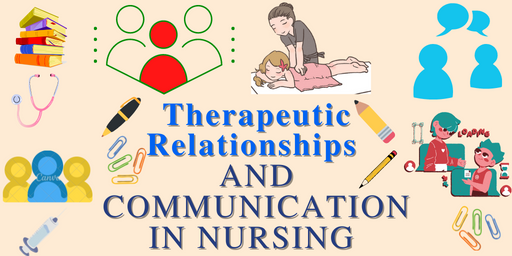Patient Nurse Relationship in Nursing

Therapeutic Relationship in Psychiatric Nursing and in nursing practice is and its phases.
Building The Therapeutic Relationship
A nurse who has confidence rooted in self-awareness is
willing to form appropriate therapeutic relationships with clients. Because
personal growth continues throughout life, the caregiver cannot expect full self-knowledge.
However, knowing your strengths and limitations at any given time is a good
start stages.
Peplau has studied and written about interpersonal
processes and the stages of the caregiver-client relationship for 35 years. Her
work provides the nursing profession with a model that can be used to
understand and document the progress of interpersonal interactions. Peplau's
(1952) model has three phases: orientation, work, and solution or completion . In real life, these phases are not so clear cut; they overlap and
intertwine.
Orientation
The orientation phase begins when the caregiver and
client meet and ends when the client begins to identify issues for
investigation. During the orientation phase, the caregiver establishes the
roles, the purpose of the meeting and the parameters of subsequent meetings;
identifies customer problems; and clarify expectations.
Before meeting the client, the nurse has an important
task to perform. The nurse reads the client's available medical history, becomes
familiar with the medications the client is taking, collects the necessary
documentation, and maintains a calm, private, and comfortable environment. This
is the time for self-assessment. The caregiver needs to consider their personal
strengths and limitations when working with this client. Are there any areas
that might indicate difficulties based on past experience? For example, if this
client is an abusive spouse and the caregiver's father was one, the caregiver
should consider the situation: How does he feel? What memories does it trigger
and can he or she work with the client without those memories interfering? The
caregiver needs to examine preconceived notions about the client and ensure
they can let go of them and get to know the real person.
The nurse must
approach each client without preconceived notions or prejudices. It may be
helpful for the caregiver to discuss any potential problem areas with the
trainer. During the orientation phase, the nurse begins to build trust with the
client. It is the nurse's responsibility to create a therapeutic environment
that promotes trust and understanding.
The nurse should provide
appropriate information about herself at this point, including name, reason for
being on the ward and level of education: For example: “Hello, James. My name
is Miss Ames and I will be your nurse for the next six Tuesdays. I'm a nursing
student at the University of Mississippi. The nurse must listen carefully to
the client's story, perceptions and misconceptions. He or she needs to convey
empathy and understanding. When the relationship starts off positively, you are
more likely to be successful and achieve the goals you set.
At the first meeting, the client may be suspicious if
previous relationships with caregivers have been unsatisfactory. The client may
use ramblings, episodes, or exaggerations to avoid discussing the real issues.
It may take several sessions before the client believes that she can trust the
caregiver.
Nurse-client contracts. Although many clients have prior
experience with the mental health system, the caregiver needs to rethink
caregiver and client responsibilities. Initially, the caregiver and patient
must agree to these responsibilities in an informal or verbal contract. In some
cases, a formal or written contract may be appropriate; Examples of this are
when a written contract with the client was required in the past or when the
client “forgets” the verbal contract.
The contract must include the time, place and duration of
the meetings.When sessions end Who will be involved in the treatment
plan (family members or members of the health care team) Client
responsibilities (arrival on time and completion on time) Caregiver
responsibilities (arrival on time, completion on time, confidentiality at all times,
evaluation of client progress and document sessions).
Confidentiality. Confidentiality means respecting the
client's right to keep all information about their physical and mental health
and related care secret. It means that only those responsible for the care of
the client have access to the information that the client discloses. Third
parties can only access this information under precisely defined conditions;
For example, in many states, employees are required by law to report suspected
child and elder abuse.
Adult clients can decide which family members, if any, are
present. they can participate in treatment and have access to clinical
information. The ideal is to involve people close to the client and responsible
for her care. However, the client must decide who gets involved. For the client
to feel safe, the limits must be clear. The caregiver must clearly identify who
has access to client assessment data and progress assessments. He or she should
tell the client that members of the mental health team will share appropriate
information with each other to ensure ongoing care and will only involve a
family member with the client's permission. If the client has a designated
guardian, that person may review the client's information and make treatment decisions
that are in the best interest of the client. For a child, the designated parent
or guardian has access to information and can make treatment decisions as
determined by the health care team.
The nurse must be vigilant when a client asks her to keep a
secret, as this information may be related to the client's harm to themselves
or others. The nurse must avoid any promise to keep secrets. If the nurse
promised not to say anything until she heard the message, she could jeopardize
the client's trust. Even if the caregiver refuses to keep the information
secret, in most cases the client will still report the problems. The following
is an example of a good response to a suicidal client who requests
confidentiality: The nurse manager and treating physician can notify both the
police and the victim.
The nurse documents the client's problems with planned
interventions. The client must understand that the nurse collects data about
him or her to help make a diagnosis, plan care (including medication), and
protect the client's civil rights. The client needs to understand the limits of
confidentiality in caregiver-client interactions and how the caregiver will use
and share this information with the professionals involved in the care of the
client.
Self-disclosure. Self-disclosure means the disclosure of
personal information, such as B. biographical information and personal ideas,
thoughts and feelings about a sale to customers. Traditionally, the
conventional wisdom was that nurses should only share their first name and give
a general idea of where they live, such as: B. “I live in Ocean County.
However, it is now believed that well-planned and targeted self-disclosure can
improve the caregiver-client relationship. The caregiver can use
self-disclosure to provide support, educate clients, and show that a client's
anxiety is normal and that many people in deal with stress and problems in
their lives.
Self-disclosure can help the client feel more comfortable
and more willing to share their thoughts and feelings, or help the client
better understand their situation. When self-reporting, the caregiver must also
consider cultural factors. Some customers may find the self-certification
inappropriate or too personal, making the customer uncomfortable. Disclosure of
personal information to a customer can be harmful and inappropriate and should
be carefully planned and considered in advance.
The spontaneous self-disclosure
of personal information can have negative consequences. For example, if you are
working with a client whose parents are divorcing, the nurse says, "My
parents divorced when I was 12 and it was a horrible time for me." The
nurse took the focus away from the client and given her the idea that this
experience will be terrible for the client. Even if the caregiver intended to
express empathy, the result can be just the opposite.
Working
The work phase of the nurse-client relationship is generally
divided into two sub-phases: During problem identification, the client
identifies the problems or concerns that are causing problems. During
exploitation, the caregiver guides the client towards the subject's feelings
and reactions and towards the development of better coping skills and a more
positive self-rescue change and image development; this promotes the behavior:
independence. (Note that Peplau's use of the word exploitation had a very
different meaning from today's usage, which implies exploiting or unfairly
exploiting a person or situation.
For this reason, this phase is best conceived
as an intensive exploration and elaboration of previous issues that the client
discussed.) The trust that has been built between the caregiver and client at
this point allows them to examine the issues and work on them in the safety of
the relationship.
The client must believe that the caregiver will not turn away
or become upset if the client reveals experiences, problems, behaviors, and
problems. Sometimes the client will use outrageous stories or exaggerated
behaviors to test the nurse. Behavior tests challenge the caregiver to stay
focused and not react or get distracted. When the client is uncomfortable with
getting too close to the truth, she often uses test behaviors to avoid the
topic. The nurse can respond by saying, "It seems we've reached an
uncomfortable point for you. Would you like to let it go now?" This
statement focuses on the real problem and distracts from the test behavior.
The caregiver must remember that it is the client who
examines and explores problematic situations and relationships. The nurse must
not judge and not give advice; The caregiver must allow the client to analyze
situations. The nurse can guide the client to observe patterns of behavior and
determine whether or not the expected response is occurring. For example, a
patient suffering from depression complains to the nurse about the lack of
attention to her children. With the support and guidance of the nurse, the
client may explore how she communicates with her children and may discover that
her communication is complaining and critical. The caregiver can then help the
client find more effective ways to communicate in the future. Tasks specific to
the work phase include:
- Maintain the relationship Collect more data
- Explore perceptions of reality. • Develop positive coping mechanisms
- Promotion of a positive self-image
- Encourage the verbalization of feelings
- Facilitate behavior change. • Work through resistances
- Evaluate progress and refine goals as needed. • Provide opportunities for the client to practice new behaviors
- Promotion of independence.
As the caregiver and client work together, it is common for
the client to subconsciously transfer feelings for loved ones to the caregiver.
This is called a transfer. For example, if the client has had negative experiences
with authority figures such as parents, teachers, or school principals, he or
she may show similar negative reactions and resistance towards the caregiver,
who is also viewed as an authority. A similar process can occur when the
caregiver responds to the client based on personal unconscious needs and
conflicts, this is known as counter transference. For example, if the caregiver
is the youngest in their family and often felt unheard as a child, they may
become annoyed with a client who does not listen or resists their help. Again,
self-awareness is important so that the caregiver can recognize when
transference and counter transference may be occurring. By being aware of these
"hot spots," the caregiver is more likely to respond appropriately
rather than allowing old unresolved conflicts to taint the relationship.
Termination
The termination or resolution phase is the final phase in
the caregiver-client relationship. It starts when the problems are resolved and
ends when the relationship ends. Both the caregiver and the client often have
feelings about ending the relationship; in particular, the customer may
perceive the termination as an imminent loss. Clients often try to avoid
termination by acting angry or by pretending the problem hasn't been resolved.
The caregiver can acknowledge the client's feelings of anger and reassure them
that this reaction is normal in order to end a relationship. When the client
attempts to reopen and discuss old resolved issues, the caregiver needs to
avoid feeling that the sessions were unsuccessful; Instead, you should identify
the client's decelerating maneuvers and refocus the client on the newly learned
behaviors and skills to cope with the problem. It is appropriate to tell the
client that the caregiver enjoyed being with them and that they will remember
it, but it is inappropriate for the caregiver to agree to see the client
outside of the therapeutic relationship.




Give your opinion if have any.